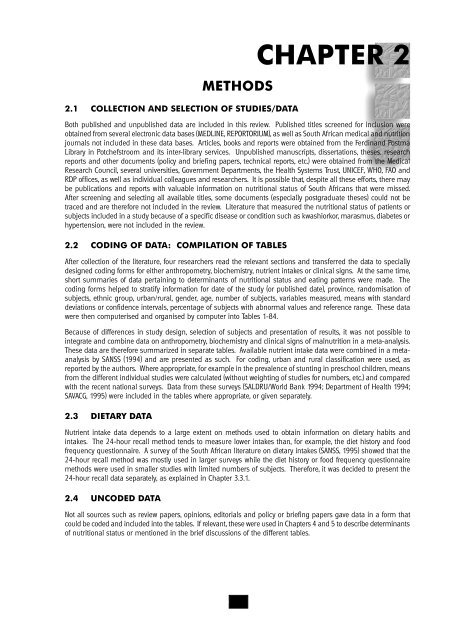the nutritional status of - Health Systems Trust
the nutritional status of - Health Systems Trust
the nutritional status of - Health Systems Trust
You also want an ePaper? Increase the reach of your titles
YUMPU automatically turns print PDFs into web optimized ePapers that Google loves.
METHODS<br />
2.1 COLLECTION AND SELECTION OF STUDIES/DATA<br />
CHAPTER 2<br />
Both published and unpublished data are included in this review. Published titles screened for inclusion were<br />
obtained from several electronic data bases (MEDLINE, REPORTORIUM), as well as South African medical and nutrition<br />
journals not included in <strong>the</strong>se data bases. Articles, books and reports were obtained from <strong>the</strong> Ferdinand Postma<br />
Library in Potchefstroom and its inter-library services. Unpublished manuscripts, dissertations, <strong>the</strong>ses, research<br />
reports and o<strong>the</strong>r documents (policy and briefing papers, technical reports, etc.) were obtained from <strong>the</strong> Medical<br />
Research Council, several universities, Government Departments, <strong>the</strong> <strong>Health</strong> <strong>Systems</strong> <strong>Trust</strong>, UNICEF, WHO, FAO and<br />
RDP <strong>of</strong>fices, as well as individual colleagues and researchers. It is possible that, despite all <strong>the</strong>se efforts, <strong>the</strong>re may<br />
be publications and reports with valuable information on <strong>nutritional</strong> <strong>status</strong> <strong>of</strong> South Africans that were missed.<br />
After screening and selecting all available titles, some documents (especially postgraduate <strong>the</strong>ses) could not be<br />
traced and are <strong>the</strong>refore not included in <strong>the</strong> review. Literature that measured <strong>the</strong> <strong>nutritional</strong> <strong>status</strong> <strong>of</strong> patients or<br />
subjects included in a study because <strong>of</strong> a specific disease or condition such as kwashiorkor, marasmus, diabetes or<br />
hypertension, were not included in <strong>the</strong> review.<br />
2.2 CODING OF DATA: COMPILATION OF TABLES<br />
After collection <strong>of</strong> <strong>the</strong> literature, four researchers read <strong>the</strong> relevant sections and transferred <strong>the</strong> data to specially<br />
designed coding forms for ei<strong>the</strong>r anthropometry, biochemistry, nutrient intakes or clinical signs. At <strong>the</strong> same time,<br />
short summaries <strong>of</strong> data pertaining to determinants <strong>of</strong> <strong>nutritional</strong> <strong>status</strong> and eating patterns were made. The<br />
coding forms helped to stratify information for date <strong>of</strong> <strong>the</strong> study (or published date), province, randomisation <strong>of</strong><br />
subjects, ethnic group, urban/rural, gender, age, number <strong>of</strong> subjects, variables measured, means with standard<br />
deviations or confidence intervals, percentage <strong>of</strong> subjects with abnormal values and reference range. These data<br />
were <strong>the</strong>n computerised and organised by computer into Tables 1-84.<br />
Because <strong>of</strong> differences in study design, selection <strong>of</strong> subjects and presentation <strong>of</strong> results, it was not possible to<br />
integrate and combine data on anthropometry, biochemistry and clinical signs <strong>of</strong> malnutrition in a meta-analysis.<br />
These data are <strong>the</strong>refore summarized in separate tables. Available nutrient intake data were combined in a metaanalysis<br />
by SANSS (1994) and are presented as such. For coding, urban and rural classification were used, as<br />
reported by <strong>the</strong> authors. Where appropriate, for example in <strong>the</strong> prevalence <strong>of</strong> stunting in preschool children, means<br />
from <strong>the</strong> different individual studies were calculated (without weighting <strong>of</strong> studies for numbers, etc.) and compared<br />
with <strong>the</strong> recent national surveys. Data from <strong>the</strong>se surveys (SALDRU/World Bank 1994; Department <strong>of</strong> <strong>Health</strong> 1994;<br />
SAVACG, 1995) were included in <strong>the</strong> tables where appropriate, or given separately.<br />
2.3 DIETARY DATA<br />
Nutrient intake data depends to a large extent on methods used to obtain information on dietary habits and<br />
intakes. The 24-hour recall method tends to measure lower intakes than, for example, <strong>the</strong> diet history and food<br />
frequency questionnaire. A survey <strong>of</strong> <strong>the</strong> South African literature on dietary intakes (SANSS, 1995) showed that <strong>the</strong><br />
24-hour recall method was mostly used in larger surveys while <strong>the</strong> diet history or food frequency questionnaire<br />
methods were used in smaller studies with limited numbers <strong>of</strong> subjects. Therefore, it was decided to present <strong>the</strong><br />
24-hour recall data separately, as explained in Chapter 3.3.1.<br />
2.4 UNCODED DATA<br />
Not all sources such as review papers, opinions, editorials and policy or briefing papers gave data in a form that<br />
could be coded and included into <strong>the</strong> tables. If relevant, <strong>the</strong>se were used in Chapters 4 and 5 to describe determinants<br />
<strong>of</strong> <strong>nutritional</strong> <strong>status</strong> or mentioned in <strong>the</strong> brief discussions <strong>of</strong> <strong>the</strong> different tables.<br />
3
















